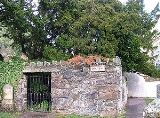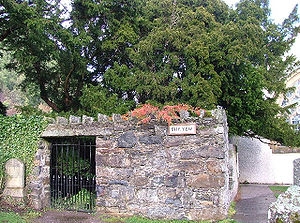
Fortingall
Encyclopedia

Perthshire
Perthshire, officially the County of Perth , is a registration county in central Scotland. It extends from Strathmore in the east, to the Pass of Drumochter in the north, Rannoch Moor and Ben Lui in the west, and Aberfoyle in the south...
, Scotland
Scotland
Scotland is a country that is part of the United Kingdom. Occupying the northern third of the island of Great Britain, it shares a border with England to the south and is bounded by the North Sea to the east, the Atlantic Ocean to the north and west, and the North Channel and Irish Sea to the...
, in the glen (or valley) of the River Lyon. Place-name Gaelic
Scottish Gaelic language
Scottish Gaelic is a Celtic language native to Scotland. A member of the Goidelic branch of the Celtic languages, Scottish Gaelic, like Modern Irish and Manx, developed out of Middle Irish, and thus descends ultimately from Primitive Irish....
Fartairchill, 'church at the foot' (i.e. of the hill slope behind the village). Its nearest sizable neighbours are Aberfeldy and Kenmore.
According to legend it was the birthplace of Pontius Pilate
Pontius Pilate
Pontius Pilatus , known in the English-speaking world as Pontius Pilate , was the fifth Prefect of the Roman province of Judaea, from AD 26–36. He is best known as the judge at Jesus' trial and the man who authorized the crucifixion of Jesus...
. This is unsubstantiated and unlikely, as the Roman conquest of Britain only took place some years after Pilate's time. A number of other locations, including villages in Spain and Germany, make similar claims.
Parish church
The parish church is on an early Christian site, dedicated to Coeddi, bishop of IonaIona
Iona is a small island in the Inner Hebrides off the western coast of Scotland. It was a centre of Irish monasticism for four centuries and is today renowned for its tranquility and natural beauty. It is a popular tourist destination and a place for retreats...
(d. 712), probably founded about 700 AD from Iona
Iona
Iona is a small island in the Inner Hebrides off the western coast of Scotland. It was a centre of Irish monasticism for four centuries and is today renowned for its tranquility and natural beauty. It is a popular tourist destination and a place for retreats...
itself as a daughter monastery. Though undocumented, crop-marks of surrounding ditched enclosures have been identified from the air, and the church's unusual dedication and fragments of several finely carved cross-slabs preserved in the church all point to an early origin as a major church site. Also preserved in an alcove in the church is an early hand-bell in Irish style (iron with bronze coating), dating from the 7th-8th centuries, one of several to have survived in Highland Perthshire
Perthshire
Perthshire, officially the County of Perth , is a registration county in central Scotland. It extends from Strathmore in the east, to the Pass of Drumochter in the north, Rannoch Moor and Ben Lui in the west, and Aberfoyle in the south...
. Several slabs with simple incised crosses (best paralleled at Iona and other west of Scotland sites) and a massive early font are to be seen in the churchyard. The attractive white-harled parish church (built 1901-02), notable for its fine woodwork, is open in summer. Its 'arts and crafts' style was designed to harmonise with the rest of the village. A permanent display on the cross-slabs and the early church was recently installed in the building. Fortingall has one of the largest collections of early medieval sculpture in Scotland
Scotland
Scotland is a country that is part of the United Kingdom. Occupying the northern third of the island of Great Britain, it shares a border with England to the south and is bounded by the North Sea to the east, the Atlantic Ocean to the north and west, and the North Channel and Irish Sea to the...
.
The yew tree
The Fortingall YewFortingall Yew
The Fortingall Yew is an ancient yew in the churchyard of the village of Fortingall in Perthshire, Scotland. Various estimates have put its age at between 2,000 and 5,000 years; recent research into yew tree ages suggests that it is likely to be nearer the lower limit of 2,000 years...
is an ancient tree in its own walled enclosure within the village churchyard, its age is estimated to be between 2000 and 5000 years, and it may be the oldest living tree - perhaps even the oldest living thing - in Europe
Europe
Europe is, by convention, one of the world's seven continents. Comprising the westernmost peninsula of Eurasia, Europe is generally 'divided' from Asia to its east by the watershed divides of the Ural and Caucasus Mountains, the Ural River, the Caspian and Black Seas, and the waterways connecting...
. Place-name and archaeological evidence hint at an Iron Age
Iron Age
The Iron Age is the archaeological period generally occurring after the Bronze Age, marked by the prevalent use of iron. The early period of the age is characterized by the widespread use of iron or steel. The adoption of such material coincided with other changes in society, including differing...
cult centre at Fortingall, which may have had this tree as its focus. The site was Christianised during the Dark Ages, perhaps because it was already a sacred place.
Village planning
The attractive village of Fortingall, with its large hotel adjoining the churchyard, was built 1890-91 by shipowner and UnionistConservative Party (UK)
The Conservative Party, formally the Conservative and Unionist Party, is a centre-right political party in the United Kingdom that adheres to the philosophies of conservatism and British unionism. It is the largest political party in the UK, and is currently the largest single party in the House...
MP, Sir Donald Currie
Donald Currie
Sir Donald Currie GCMG was a British shipowner.Currie was born in Greenock, Scotland. However, he spent his school days in Belfast at the Belfast Academy and later at the Royal Belfast Academical Institution and at a very early age he was employed in the office of a shipowner in that port...
(1825–1909), who bought the Glenlyon Estate, including the village, in 1885. It was designed by the architect James M MacLaren
James MacLaren (architect)
James Marjoribanks MacLaren was a Scottish architect associated with the Arts and Crafts movement and the development of Scottish Vernacular architecture...
(1853-90). The thatched cottages are notable examples of a planned village built in vernacular style (here combining both Lowland Scottish and English influences, notably from Devon
Devon
Devon is a large county in southwestern England. The county is sometimes referred to as Devonshire, although the term is rarely used inside the county itself as the county has never been officially "shired", it often indicates a traditional or historical context.The county shares borders with...
) and are increasingly appreciated as one of the most important examples of 'arts and crafts
Arts and crafts
Arts and crafts comprise a whole host of activities and hobbies that are related to making things with one's hands and skill. These can be sub-divided into handicrafts or "traditional crafts" and "the rest"...
' vernacular style in Scotland
Scotland
Scotland is a country that is part of the United Kingdom. Occupying the northern third of the island of Great Britain, it shares a border with England to the south and is bounded by the North Sea to the east, the Atlantic Ocean to the north and west, and the North Channel and Irish Sea to the...
. The Fortingall Hotel, recently (2006-07) restored to its original appearance, is an important example of Scottish vernacular revival. Based on the tower-houses and burgh architecture of the 16th-17th centuries, but in a modern idiom which anticipates the buildings of Charles Rennie Mackintosh
Charles Rennie Mackintosh
Charles Rennie Mackintosh was a Scottish architect, designer, watercolourist and artist. He was a designer in the Arts and Crafts movement and also the main representative of Art Nouveau in the United Kingdom. He had a considerable influence on European design...
, whose work MacLaren influenced.
Glenlyon House, and its adjoining Farm and steading, west of the village, were also designed, or largely rebuilt, to MacLaren's designs.
Archaeology
The area immediately surrounding Fortingall has one of the richest concentrations of prehistoric archaeologicalArchaeology
Archaeology, or archeology , is the study of human society, primarily through the recovery and analysis of the material culture and environmental data that they have left behind, which includes artifacts, architecture, biofacts and cultural landscapes...
sites in Scotland, including Càrn na Marbh
Carn na Marbh
Càrn na Marbh is a re-used Bronze Age tumulus, located in Fortingall in Perthshire, Scotland. The mound was used in the 14th century for burying victims of the plague away from the church graveyard...
, Gaelic
Gaelic
Gaelic is an adjective that means "pertaining to the Gaels", including language and culture. As a noun, it may refer to the group of languages spoken by the Gaels, or to any one of the languages individually.-Gaelic languages:...
'Cairn of the Dead', a re-used bronze Age
Bronze Age
The Bronze Age is a period characterized by the use of copper and its alloy bronze as the chief hard materials in the manufacture of some implements and weapons. Chronologically, it stands between the Stone Age and Iron Age...
tumulus
Tumulus
A tumulus is a mound of earth and stones raised over a grave or graves. Tumuli are also known as barrows, burial mounds, Hügelgrab or kurgans, and can be found throughout much of the world. A tumulus composed largely or entirely of stones is usually referred to as a cairn...
that was used as a burial ground in the 14th century and a focus for the villages Samhain
Samhain
Samhain is a Gaelic harvest festival held on October 31–November 1. It was linked to festivals held around the same time in other Celtic cultures, and was popularised as the "Celtic New Year" from the late 19th century, following Sir John Rhys and Sir James Frazer...
festival. Other sites include standing stone
Standing stone
Standing stones, orthostats, liths, or more commonly megaliths are solitary stones set vertically in the ground and come in many different varieties....
s, 'four-poster' stone settings, 'ring-forts' (massive Iron Age house enclosures), many cup and ring mark
Cup and ring mark
Cup and ring marks or cup marks are a form of prehistoric art found mainly in Atlantic Europe and Mediterranean Europe although similar forms are also found throughout the world including Mexico, Brazil, Greece, and India, where...
ed stones (including one dug-up, and preserved, in the churchyard) and an extremely well-preserved medieval homestead moat, thought by early antiquarians to be of Roman origin because of its regular shape.
Fortingall parish (now linked with Glenlyon) is one of the largest on Scotland, and takes in Glen Lyon
Glen Lyon, Scotland
Glen Lyon is a glen in the Perth and Kinross region of Scotland. It is the longest enclosed glen in Scotland and runs for 34 miles from Loch Lyon in the west to the village of Fortingall in the east....
, notable for its mountain scenery and many archaeological sites, the country's longest enclosed glen or mountain valley.
Further reading
- Fraser, D 1973 Highland Perthshire, Standard Press, Montrose.
- Perth & Kinross Heritage Trust 2003 Fortingall Church and Village, Perth.
- Robertson, N M 1997 'The Carved Stones of Fortingall' in Henry, D (ed) The worm, the germ and the thorn: Pictish and related studies presented to Isabel Henderson, The Pinkfoot Press, Balgavies, Angus, 133-48.
- Stewart, Alexander "A Highland Parish or The History of Fortingall", A Maclaren and Co, Glasgow, 1928

